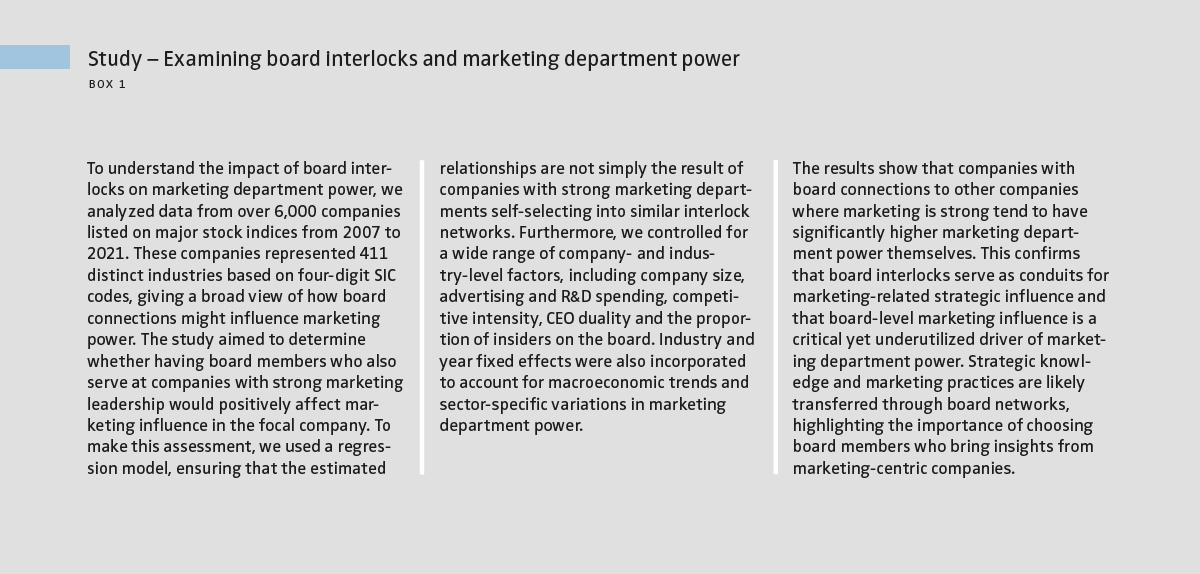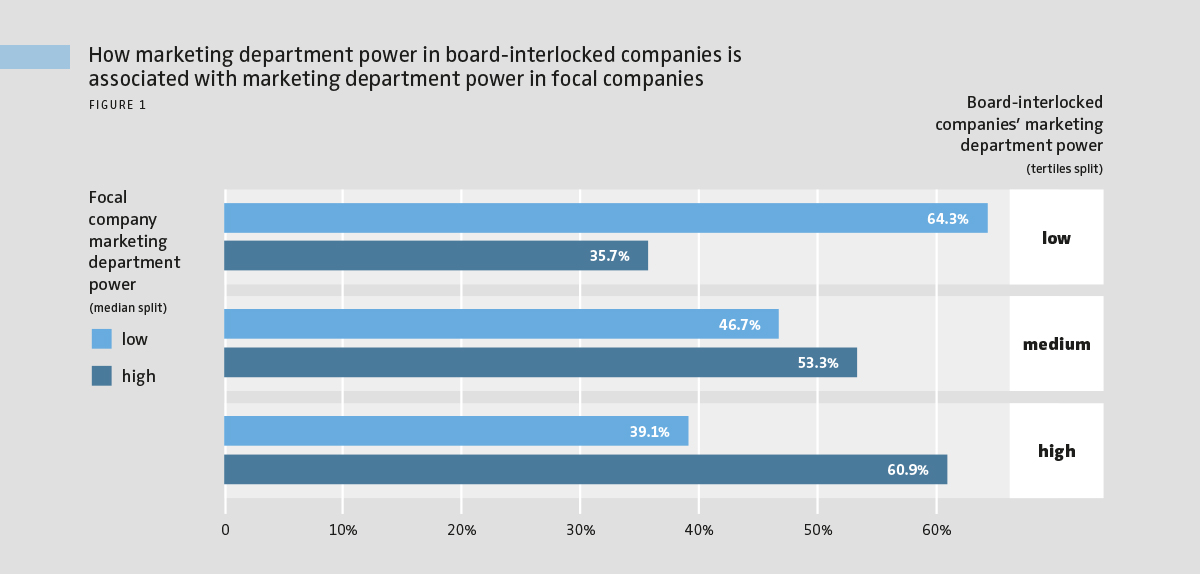(Re)Claiming Marketing’s Strategic Role: Get the Board on Board!
Over the past 15 years, marketing departments have seen their influence within organizations decrease. This is evident in the shrinking presence of marketers in top positions and the gradual erosion of marketing’s decision-making authority in critical areas such as pricing, product development and customer strategy. For instance, my recent research together with colleagues shows that the percentage of companies with a marketer on the top management team dropped from 37.0% in 2007 to 28.9% in 2021. While evidence consistently shows that strong marketing leadership correlates with better company performance, marketing’s strategic impact has nonetheless diminished. This weakening poses a significant risk, as marketing is fundamental to driving organic growth, acquiring and retaining customers and building brand equity. However, recent insights suggest that a strategic factor has been overlooked: the role of corporate boards, specifically board interlocks, in shaping marketing department power.
Board interlocks as a strategic lever
Board interlocks, where directors serve on multiple boards, act as channels for marketing knowledge and best practices. The key findings of our study (Box 1) show that companies with connections to other companies with strong strategic marketing departments are more likely to enhance their own marketing influence. Figure 1 shows the positive association between marketing department power in board-interlocked companies and focal firms. As the marketing department power in board-interlocked firms moves from low to medium to high, the percentage of focal companies with high marketing power moves from 35.7% to 53.3% to 60.9%. This highlights the need for marketing leaders to proactively engage with boards and leverage interlock networks to reinstate marketing’s strategic role.
How companies benefit from board interlocks
In our study, we further examined why some companies benefit more from board interlocks than others. We tested and confirmed that three dimensions – reach, richness and receptivity – play a key role in leveraging board influence to strengthen marketing department power (see Figure 2). Companies with broad but less interconnected board-interlocked networks and hence a greater reach, as well as connections to companies in similar industries – greater richness – experience the strongest board interlock effects on marketing department power. Moreover, companies with a marketer on the board or on the leadership team demonstrate greater receptivity, making them more likely to leverage marketing insights from board-interlocked companies. These results underscore a link between governance structures and marketing influence, reinforcing the importance of board interlocks in shaping marketing department power.
The role of boards in reversing the marketing power decline
As boards set the strategic direction and oversee top management, their perception of marketing’s value directly impacts its organizational standing. Given the evidence that board interlocks influence marketing power, boards of directors can play an important role in reversing its decline. We suggest several ways they can contribute.
> Recognize that marketing is more than a cost center
First, boards should actively challenge the misconception that marketing is merely a cost center. Instead, they should recognize its role in driving revenue and company value. Boards should ensure that marketing strategy aligns with broader corporate objectives. By integrating marketing into overall strategic and financial goals, boards can foster an environment where marketing is seen as a growth driver rather than an auxiliary function.
> Support marketing presence in the C-suite
Second, boards should advocate for stronger marketing leadership in the C-suite. A key indicator of marketing department power is the presence of marketing professionals on the executive team. Boards should encourage CEO appointments that favor marketing experience and push for CMOs to have a seat at the decision-making table. In addition, increasing marketer representation on boards is likely beneficial. As companies can expect to benefit financially from a powerful marketing department, the presence of marketing professionals at the board level can lead to better alignment between marketing objectives and corporate goals, fostering a culture in which marketing is seen as a key contributor to business success rather than a support function.
> Support knowledge transfer in all directions
Third, boards can leverage their interlocks not only to spread best marketing practices but also to learn from them. Interlocked directors serve as conduits of strategic knowledge, transferring insights on effective marketing strategies between the companies on whose boards they serve. Those with exposure to companies with high marketing department power can bring marketing-friendly governance models to companies where marketing holds less influence, elevating its strategic role. Additionally, as companies face pressure to drive organic growth, board members can actively seek out and adopt proven marketing strategies from their networks.
To counteract the decline of marketing department power and leverage board influence, marketing leaders should proactively engage their boards.
How marketing leaders can engage boards more effectively
To counteract the decline of marketing department power and leverage board influence, marketing leaders should proactively engage their boards.We suggest the following practical activities.
> Encourage boards to include marketing-relevant members
First, marketing leaders should strategically encourage boards to connect with other boards in ways that maximize the influence of board interlocks on marketing department power. They should encourage their boards to include directors who are already on the boards of companies with high marketing department power. Furthermore, they should help their boards expand their reach by encouraging directors to interlock with companies that are not already connected to any of the companies on their board. This reduces redundancy and ensures exposure to new and diverse strategic perspectives on marketing’s role in driving company performance. Furthermore, marketing leaders should focus on increasing the richness of the information exchanged in board interlocks. This means fostering connections with companies in related industries, where marketing insights are more applicable and transferable to their own strategic context. In addition, marketing leaders should improve their companies’ receptivity to marketing insights from board interlocks. Companies that already have marketing leaders on their boards or on their top management teams are more likely to act on marketing-related knowledge gained through interlocks.
> Actively engage board members with marketing and its financial impact
Second, marketing leaders should engage the board directly by demonstrating marketing’s financial impact on company performance. Since boards prioritize growth and shareholder value, CMOs should communicate marketing’s contribution through concrete financial metrics tied to revenue, profitability and customer acquisition or retention. Companies that deploy marketing analytics effectively can achieve a significant increase in return on assets, yet many executives remain skeptical of its benefits. To overcome this, fostering board-level marketing literacy is important. Marketing leaders should showcase how data-driven marketing strategies create value not only for the customer but also for the company. Aligning “value to customer” metrics with “value to company” metrics strengthens marketing’s case in the boardroom, ensuring that marketing is seen as a strategic driver of company value rather than a cost center.
Get the board on board to keep marketing in the inner circle
The decline of marketing power is neither inevitable nor irreversible. Marketing leaders should use board interlocks as a strategic lever for influence. They can engage their boards by influencing how they connect with other companies. As board interlocks serve as conduits for marketing knowledge, companies connected to other companies with powerful marketing departments are more likely to strengthen their own marketing influence. Boards, in turn, have the capacity to champion marketing by recognizing its importance and advocating for marketing leadership on the executive team and board. Through stronger collaboration with boards and a focused effort to showcase marketing’s contributions to company success, marketing leaders can ensure that their departments gain their place at the decision-making table. It starts by getting the board on board!
FURTHER READINGS
Ebbes, P., Germann, F., & Grewal, R. (2025). Getting the board on board: Marketing department power and board interlocks. Journal of Marketing Research, 62(1),
1-21. https://doi.org/10.1177/00222437241272180
Feng, H., Morgan, N., & Rego, L. (2015). Marketing department power and company performance. Journal of Marketing, 79(5), 1-20. https://doi.org/10.1509/jm.13.0522
Germann, F., Ebbes, P., & Grewal, R. (2015). The chief marketing officer matters! Journal of Marketing, 79(3), 1-22. https://doi.org/10.1509/jm.14.0244
Gulati, R., Lavie, D., & Madhavan, R. (2011). How do networks matter? The performance effects of interorganizational networks. Research in Organizational
Behavior, 31, 207-224. https://doi.org/10.1016/j.riob.2011.09.005
Verhoef, P., Kooge, E., Walk, N., &. Wieringa, J. (2022). Creating value with data analytics in marketing: Mastering data science (2nd ed.). Routledge.













